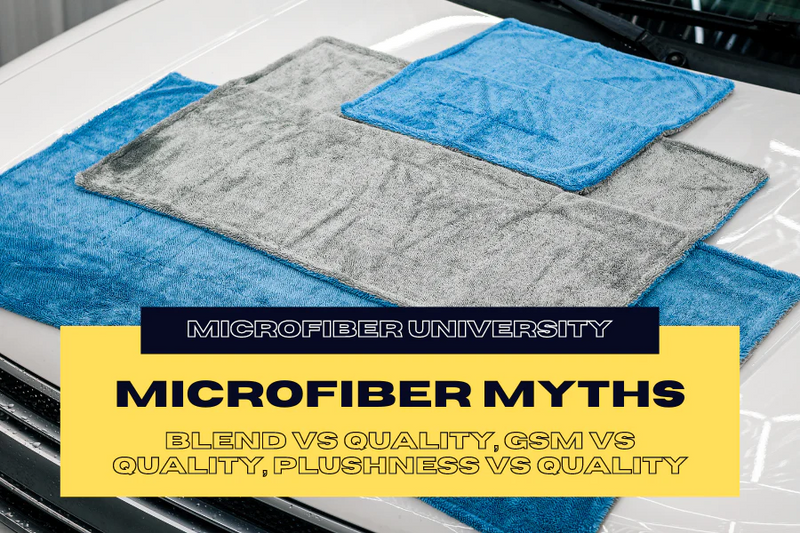
Quality vs. GSM/Blend/Pile
Quality vs. GSM/Blend/Pile
There is a lot of confusion (and misinformation) about the quality of microfiber towels. What makes a microfiber “quality”?
- Is it the GSM?
- Is it the blend (70/30, 80/20, 100% poly)?
- Is it the pile or plushness?
Many detailers and detailing suppliers confuse the GSM (weight), blend (composition) and/or pile (feel), with the quality of the towel. While all of these factors play a role in the overall quality of the product, none of them equate exactly with the “quality” of the towel.
It is easy to think that higher specification numbers mean quality, but that isn’t the case.
- Higher GSM isn’t always higher quality.
- Higher ratio of polyamide to polyester isn’t always higher quality.
- Higher pile (and/or the softness of the feel) isn’t always higher quality.
There is something more fundamental than all of these specifications, which is the quality and fineness of the yarn. There are different qualities of microfiber yarn. When we design a product we can choose a specific yarn specification that will produce a certain result. For example, the Mr. Everything, Quadrant Wipe and Korean Plush have been developed with a special ultra-fine, low denier (extra thin) yarn that doesn’t scratch the most delicate of surfaces. The yarn used on glass towels is different from drying towels.
Other factors in the “quality” of a towel, separate from the yarn quality, is the design and construction. The first step in creating a new towel is the design and the last step is the construction (the actual cutting and sewing of the final product). The design of most towels, beyond choosing the yarn and type of machine that the material is woven on, is simple. We choose the size, weight, color and edge type.
Most microfiber detailing towels now-a-days are “edgeless”. The main two ways that these towels are made is: “ultra-sonic cut”, and “hidden edge”. Ultra-sonic cut towels are finished using a machine with a blade that vibrates at a high frequency. The vibration creates a minimal but sufficient amount of heat which sears the edge and prevents it from fraying over time. It is very easy to get this wrong: if you create too much heat then the edges become hard and can scratch, not enough heat and the edges will fray. The ultrasonic cutting edge becomes dull as it cuts and needs to be replaced. If it is not replaced, then the towels can end up with serrated and non-uniform edges. Our Hidden-Edge towels (Dreadnought, Royal Plush, Amphibian) are double layered towels with edges that are tucked, sewn together and hemmed. It creates a longer lasting and more robust edge, which is resistant to fraying and doesn’t rely on an ultrasonic blade. They take more time and effort to create, but for higher quality towels, it is worth it.
But Wait!!! GSM, Blend and Pile Do matter.
GSM Does Matter - Higher GSM towels absorb more and, all else being equal, are thicker. They use more microfiber and are often more expensive. But they can be made with low quality yarn and constructed in a low-quality manner.
Blend Does Matter - All else being equal, a higher ratio of polyamide is “higher quality”. Polyamide is more expensive than polyester, and more absorbent. But be careful, 70/30 towels are not always paint safe. They can be made with low quality yarn, poor construction and are often mis-marked by the factory or distributor.
Pile Does Matter - Higher pile towels feel more impressive in hand, but that doesn’t mean that they are always the right towel for the job. High pile towels can create more friction when wiping wet surfaces, and are more likely to lint (especially on glass). We make some low pile towels (Mr. Everything, and F-Lint) which are made with ultra-fine, premium yarn.
The bottom line is that there is more to a towel than just the common specifications that they are marked with. You cannot feel the quality of a towel. The quality of a towel should be judged in it’s utility in the task being preformed.
Credit : Autofiber.com
